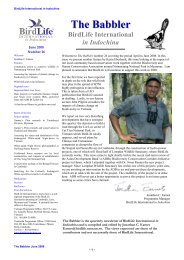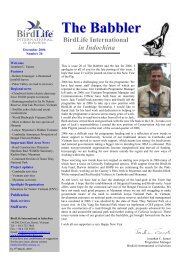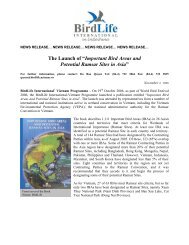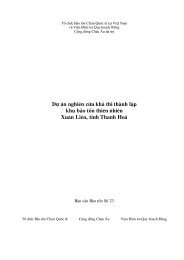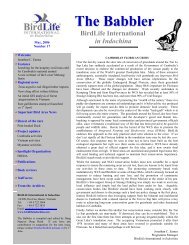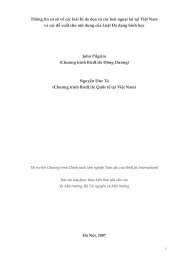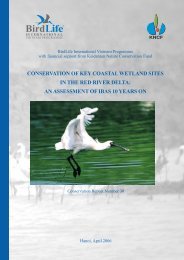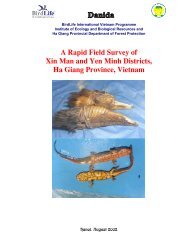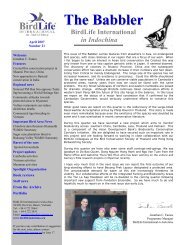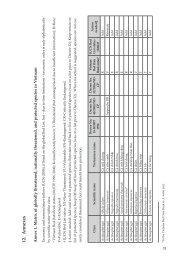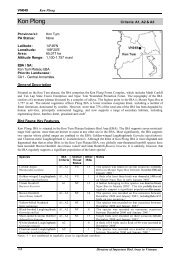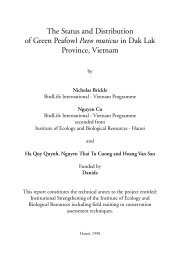Myanmar: Investment Opportunities in Biodiversity Conservation
Myanmar: Investment Opportunities in Biodiversity Conservation
Myanmar: Investment Opportunities in Biodiversity Conservation
Create successful ePaper yourself
Turn your PDF publications into a flip-book with our unique Google optimized e-Paper software.
BIOLOGICAL IMPORTANCE<br />
Geography, climate and history<br />
<strong>Myanmar</strong> is situated <strong>in</strong> the north-west of the Indoch<strong>in</strong>ese pen<strong>in</strong>sula, and is bordered to the west by the<br />
People's Republic of Bangladesh and the Republic of India, to the north-east by the People's Republic of<br />
Ch<strong>in</strong>a, and to the east by Lao PDR and the K<strong>in</strong>gdom of Thailand (Figure 1). <strong>Myanmar</strong> is the largest country <strong>in</strong><br />
ma<strong>in</strong>land South-East Asia, with a land area of 676,553 km 2 and a coastl<strong>in</strong>e of 2,832 km.<br />
<strong>Myanmar</strong> exhibits extraord<strong>in</strong>ary topographical diversity. The country spans an elevational range of nearly<br />
6,000 m, from the summit of Hkakaborazi, South-East Asia's highest mounta<strong>in</strong>, at 5,881 m asl, to the shores of<br />
the Andaman Sea and the Bay of Bengal. Between these two extremes, the country encompasses several<br />
mounta<strong>in</strong> ranges, extensive lowland pla<strong>in</strong>s, and one of Asia's largest river deltas. The country also <strong>in</strong>cludes all<br />
or part of five major rivers: the Ayeyarwady (Irrawaddy), Thanlw<strong>in</strong> (Salween), Ch<strong>in</strong>dw<strong>in</strong>, Sittaung and Mekong.<br />
The major mounta<strong>in</strong> ranges <strong>in</strong> the country comprise: the Eastern Himalayas, which dom<strong>in</strong>ate the topography of<br />
the far north of the country; the Ch<strong>in</strong> Hills, which extend south from the <strong>in</strong>ternational border with India; the<br />
Rakh<strong>in</strong>e Yoma Range, which extends south from the <strong>in</strong>ternational border with Bangladesh, between the<br />
Ayeyarwady River and the Bay of Bengal; the Bago Yoma Range, which lies between the Ayeyarwady and<br />
Thanlw<strong>in</strong> Rivers; and the Tan<strong>in</strong>tharyi Range, which runs along the <strong>in</strong>ternational border with Thailand <strong>in</strong> the<br />
south of the country. The topography of the north-east of the country is dom<strong>in</strong>ated by the Shan Plateau, which<br />
averages around 1,000 m asl. The Ayeyarwady Pla<strong>in</strong>s dom<strong>in</strong>ate the topography of the centre of the country.<br />
<strong>Myanmar</strong> has a tropical monsoon climate. Dur<strong>in</strong>g the ra<strong>in</strong>y season (May to September), most parts of the<br />
country experience a wet, humid climate, dom<strong>in</strong>ated by the south-west monsoon. Dur<strong>in</strong>g the dry season<br />
(October to April), drier conditions prevail throughout much of the country, under the <strong>in</strong>fluence of the northeast<br />
monsoon. This general pattern disguises extreme variation <strong>in</strong> climate with<strong>in</strong> the country, with mean annual<br />
ra<strong>in</strong>fall rang<strong>in</strong>g from under 500 mm <strong>in</strong> the centre of the country up to a high of 6,000 mm <strong>in</strong> Tan<strong>in</strong>tharyi Division<br />
and northern Rakh<strong>in</strong>e State.<br />
The Ayeyarwady floodpla<strong>in</strong>, sheltered from south-west and north-east monsoons by a horseshoe of mounta<strong>in</strong><br />
ranges, has an extremely dry and seasonal climate, which has given rise to specialised vegetation types, <strong>in</strong>clud<strong>in</strong>g<br />
thorn scrub and deciduous dipterocarp forest. These dry scrub and forest landscapes have been isolated<br />
from similar landscapes <strong>in</strong> South-East Asia and the Indian Sub-cont<strong>in</strong>ent for significant periods of geological<br />
history. As a result, the area, termed the Central Dry Zone, supports a number of endemic species. This area<br />
has also experienced extensive and prolonged anthropogenic modification. Other centres of endemism <strong>in</strong> <strong>Myanmar</strong><br />
<strong>in</strong>clude the mounta<strong>in</strong> ranges <strong>in</strong> the north and south of the country. However, the montane forest habitats of these<br />
mounta<strong>in</strong>s have not been isolated from similar habitats <strong>in</strong> the ma<strong>in</strong> Himalayan cha<strong>in</strong> for as long as those of<br />
certa<strong>in</strong> other mounta<strong>in</strong> ranges <strong>in</strong> ma<strong>in</strong>land South-East Asia, such as the Annamite Mounta<strong>in</strong>s. Perhaps as a<br />
result, these mounta<strong>in</strong> ranges appear to support only moderate levels of vertebrate endemism. Several freshwater<br />
systems <strong>in</strong> the country, such as Inle Lake, have also been isolated for significant periods of geological<br />
history, result<strong>in</strong>g <strong>in</strong> the evolution of endemic taxa.<br />
Habitats and ecosystems<br />
The major ecosystems <strong>in</strong> <strong>Myanmar</strong> can be grouped <strong>in</strong>to forest, freshwater, coastal and mar<strong>in</strong>e, although<br />
this report does not cover mar<strong>in</strong>e ecosystems. In the early 2000s, <strong>Myanmar</strong> had a forest cover of about<br />
429,000 km 2 (equivalent to 66% of the country's land area), plac<strong>in</strong>g it among the countries with the largest<br />
rema<strong>in</strong><strong>in</strong>g forest cover <strong>in</strong> ma<strong>in</strong>land South-East Asia (Leimgruber et al. 2004). Forest types range from lowland<br />
wet evergreen forest <strong>in</strong> the south of the country, to sub-alp<strong>in</strong>e forest at high elevations <strong>in</strong> the far north.<br />
One of the most species-rich forest types <strong>in</strong> the country is lowland wet evergreen forest, which is distributed<br />
<strong>in</strong> areas of high mean annual ra<strong>in</strong>fall and low seasonality, predom<strong>in</strong>antly close to the coast. This forest type<br />
is characterised by a species-rich tree flora, dom<strong>in</strong>ated by members of the Dipterocarpaceae. Good accessi-<br />
<strong>Myanmar</strong>: <strong>Investment</strong> <strong>Opportunities</strong> <strong>in</strong> <strong>Biodiversity</strong> <strong>Conservation</strong><br />
3




